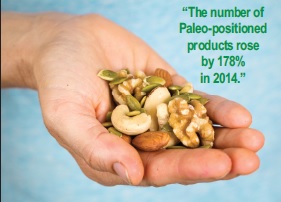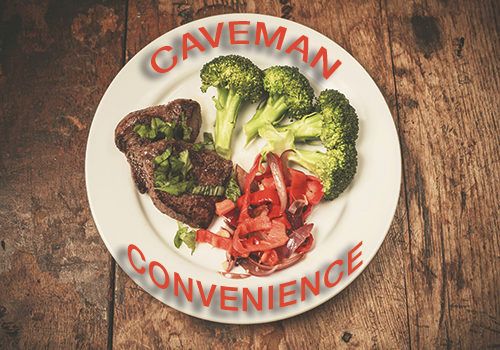For two years running, Paleo has topped Google’s most searched list for diets (1, 2) and it has frequently been boosted into the public eye by celebrity followers like golfer Phil Mickelson (3), and more recently, Republican presidential candidate Jeb Bush (4). With an estimated three million individuals who follow the Paleo diet (5), this passionate community of consumers and food companies is growing—the number of Paleo-positioned products rose by 178% in 2014 (5)—and doesn’t appear to be going away anytime soon.
Health Benefits
Also known as the caveman or ancestral health diet, Paleo, short for Paleolithic diet, is inspired by the belief that the modern human diet, heavy on processed foods, is incompatible with our bodies—that we’re better suited for the diet of our hunter-gatherer ancestors from the Paleolithic age (2.5 million to 10,000 BC) (6). The main culprits are grains, introduced to the human diet during the agricultural revolution of the Neolithic age (10,000 BC to present), but the Paleo diet also eschews legumes, artificial coloring, artificial sweeteners, artificial preservatives and (depending on who you ask) dairy.
 Eileen Forte, CEO of Paleo Simplified, Tarpon Springs, FL, cites grains as the cause of several health concerns including inflammation, gut irritability, leaky gut, interference with nutrient uptake and increased blood sugar. In the western diet, 85% of cereal grains are refined—such as white flour, white rice and white bread (7)—and account for the single largest source of carbohydrates, from which we get 45–65% of our daily energy (6). These refined grains have high glycemic index (GI) values, meaning they’re absorbed quickly during digestion and cause larger spikes in blood sugar than foods with low GI values (8). Studies have shown those consuming diets with low GI foods have a lower risk of developing type-2 diabetes, and diets heavy on high-GI foods are associated with a greater risk of coronary heart disease (9).
Eileen Forte, CEO of Paleo Simplified, Tarpon Springs, FL, cites grains as the cause of several health concerns including inflammation, gut irritability, leaky gut, interference with nutrient uptake and increased blood sugar. In the western diet, 85% of cereal grains are refined—such as white flour, white rice and white bread (7)—and account for the single largest source of carbohydrates, from which we get 45–65% of our daily energy (6). These refined grains have high glycemic index (GI) values, meaning they’re absorbed quickly during digestion and cause larger spikes in blood sugar than foods with low GI values (8). Studies have shown those consuming diets with low GI foods have a lower risk of developing type-2 diabetes, and diets heavy on high-GI foods are associated with a greater risk of coronary heart disease (9).
Several studies specific to the Paleo diet have found beneficial health effects. In one study, type-2 diabetics enjoyed “greater benefits on glucose control and lipid profiles…[and] a significant improvement in insulin sensitivity” when on the Paleo diet than on the American Diabetics Association recommended diet (10). In another, the Paleo diet lowered blood pressure and cholesterol in patients with metabolic syndrome (in which an individual has increased risk of heart disease, stroke and diabetes) (11). The Paleo diet proved to have positive effects in a pilot study testing short-term diet intervention, leading to reduced weight, body mass index, waist circumference and systolic blood pressure in participants (12).
Snacking Paleo
Given the diet’s restrictions and focus on unprocessed food, many paleo-friendly products are largely aimed at one need: convenient snacking. “While a wide range of products are certified, most of our products fall under the category of snacks, desserts and meat-based protein bars,” says Karen Pendergrass, founder and executive director of the nonprofit Paleo Foundation, which also runs a number of Paleo certification programs.
Though consumers may be devoted to and conscious of the importance of crafting major meals appropriate for the Paleo diet, it can be harder to stick to the diet during moments in between, according to Jason Burke, founder and CEO of The New Primal, John’s Island, SC. “The moments when I was sitting at my desk in the middle of the afternoon was when I was most vulnerable to go to the snack machine and compromise,” he says.
The Paleo ideal extends to the animals from which the meat is sourced, meaning free-range and grass-fed. The New Primal satisfies the Paleo requirements and convenience issue with jerky products, made from grass-fed beef and free-range turkey. “We plan to develop three new items in 2016, all aiming to continue to aid our consumers in their dietary journey, and take the guesswork out of what to pack in the purse, backpack or briefcase,” Burke adds.
Also in the Paleo meat snack space is Epic Bar, Austin, TX, which offers “grab-and-go” meat-based protein bars and jerky in bison, beef, bacon, chicken and turkey flavors. The company recently added to this variety with “an organ meat jerky that makes it easier for consumers to eat high-quality liver,” says Taylor Collins, co-founder and CEO of Epic Bar.
For consumers who miss classic grain-derived treats, WB Kitchen’s Ona bars and cookies offer a sweet Paleo diet alternative. Available in flavors like Brownie and Peanut Butter Honey, the base cookie ingredients of flour and sugar are substituted with raw unfiltered honey and almond flour. “[They] satisfy those sweet cravings we all get, without refined sugars or preservatives,” says Chris Feuille, founder and president of WB Kitchen, Loveland, CO. “Staying true to the Paleo lifestyle requires commitment and time to prepare most every meal. We know that not everyone has the time or desire to make all the food they consume, and with the growing food sensitivities manifesting in people, we see the need for more variety in grocery and on-the-go items.”
Though a large focus of Steve’s PaleoGoods, Pennsauken Township, NJ, is on-the-go convenience, taking shape in vacuum-sealed bags of jerky, dried fruits and nuts, the company also offers pantry essentials, “products that help people make every meal Paleo,” says owner Steve Liberati. This includes salad dressings, steak sauce, hot sauce and even ketchup.

Natural Sweeteners
One potential complication for snack makers is the low-sugar principle of the Paleo diet. Refined sugar is not an option.
“Ultimately, if the product doesn’t taste good, no one is going to eat it,” Burke says. “It’s very difficult to make a jerky product that doesn’t have the texture of a brick without adding some kind of sweetener to the recipe.” To compensate for softening and sweetness, New Primal uses a combination of pineapple juice and honey.
Honey, or specifically raw unfiltered honey, is also the favored sweetener at WB Kitchen, though it comes at a price. “Staying true to Paleo and Primal lifestyles, all of our products are sweetened exclusively with honey. It is easy to make a Paleo treat taste good, but high-quality unrefined sweeteners are not cheap and therefore you do not see them in most products,” Feuille adds.
At Epic Bar, the low sugar challenge is taken as an opportunity. “Our products naturally skew to the side of savory whereas most other snack products in the market favor sweet. This is a major differentiator in our taste, but also an opportunity to fill a void in the market,” Collins says.
Other companies are more than satisfied with the sugar alternatives in the Paleo space. For Paleo Passion Foods’ Paleo Passion Pops, a line of fruit popsicles, the natural sweetness of the fruit ingredients removes the need for added sugar. “It’s nearly impossible to find a frozen treat that isn’t filled with added sugars or artificial sweeteners, so we have created a product that is sweetened with just real, wholesome fruits,” says Kayla Cord, marketing director at Paleo Passion Foods, Greenwich, CT.
At Paleo Simplified, dates and goji berries keep the bars sweet but not too sugary, providing a glycemic load that is “less than an apple,” according to Forte. “Most people that follow a Paleo diet, unless they are totally sugar free, have no problem with the amount of sugar in our bar,” she says.
Forte also notes that once people become accustomed to the Paleo diet, their “taste buds do adapt to craving less sugar. Artificial sugars—even stevia—are 300–600 times sweeter than sugar. We have become accustomed to that level of sugar, but that diminishes as our eating becomes ‘cleaner,’ which is great.”
Identifying Paleo Products
The main difficulty for Paleo diet followers may just be in finding appropriate products in the first place. While whole foods, such as fruits, vegetables and meats, are easy to identify as Paleo-appropriate, the absence of a Paleo-specific section in stores can make the process confusing or research-heavy with any other food products.
“One of the earliest pieces of advice given to Paleo adherents is to shop the periphery of the store, and avoid the middle aisles. Though the bulk of that is good advice for Paleo adherents, now there are great Paleo-friendly items which can be found in the center aisles and even in refrigerated sections, but they require a little awareness, and at times a little hunting and gathering to track down,” says Pendergrass. “Unfortunately, if they do not instantly recognize an item as Paleo, they may overlook some gems and instead opt for something less desirable.”
Epic uses packaging to communicate the firm’s Paleo values, with classic illustrations of animals in muted colors. “The fact that we have an animal on the front of the bag breaks up the homogenous landscape of other products. The fact that we communicate visually that our products are based on high-quality animal meat helps Paleo consumers become drawn to our brand,” Collins says.
According to some companies, the safest option, while time-consuming, is for consumers to read the ingredient list. “We have a saying at my company: ‘Check the deck.’ When you flip a package to read an ingredient list, you should be able to pronounce each word,” says Liberati. “I challenge the consumer to do their own certification by not only knowing the ingredients in each product, but also researching the companies they buy from. Knowing how a product is made is just as important as knowing the ingredients.”
While companies like Paleo Passion Pops and Paleo Simplified proclaim their Paleo-association in their name, New Primal shied from the label because of how little known it was at the start. “Initially, we didn’t want to put the words ‘Paleo’ on our packaging because early on we thought it might cause too much consumer confusion. We were making Paleo jerky at the local level five years ago and no one had a clue what that term meant,” Burke says. “With having a brand name like ‘The New Primal,’ we’ve felt it was implied and that the Paleo consumer would easily recognize us. That said, I think third-party certifications are a healthy check and balance to ensure greater consumer confidence in the label claims and a higher level of transparency from food producers.”
 The Paleo Foundation’s certification programs aim to boost the visibility of these items with a certification logo, akin to “KosherEarth” or “Vegan.” There are currently four label categories, evidence of the Paleo diet’s complicated and variable definition. “If you ask 10 people what it means to follow a Paleo lifestyle, you will more than likely get 10 different responses,” says Forte. “That’s one of its downfalls as well as its strength. The adaptability of this diet to make it work for an individual’s own preferences makes it an easy diet to follow.”
The Paleo Foundation’s certification programs aim to boost the visibility of these items with a certification logo, akin to “KosherEarth” or “Vegan.” There are currently four label categories, evidence of the Paleo diet’s complicated and variable definition. “If you ask 10 people what it means to follow a Paleo lifestyle, you will more than likely get 10 different responses,” says Forte. “That’s one of its downfalls as well as its strength. The adaptability of this diet to make it work for an individual’s own preferences makes it an easy diet to follow.”
While a higher standard is set for Certified Paleo (13), a label created in 2014, Paleo Friendly certification follows a “wider set of community guidelines” according to Pendergrass, accepting “gray-area” products like kombucha, agave nectar, cane sugar, gums, gelatin, collagen, gums (gum Arabic, guar gum and xanthin gum), stabilizers like sunflower lecithin and natural flavors and coloring (vanillin, limonene, castoreum and carmine) (14).The oldest certification is Paleo Approved, started in 2009 and specific to meats from farms and ranches. Cattle, for instance, are required to be grass-fed and grass-finished, humanely treated, free range, antibiotic and hormone free (15).
“Right now, our focus is to help Paleo consumers readily identify safe options and products that fit into their lifestyle, and increase visibility for Paleo products within the Paleo community,” Pendergrass says. In addition to permitting companies the use of their labels after passing the certification process, the Paleo Foundation is active in promoting certified products in its community network, through social media, websites, the Paleo Business Directory and its in-house Paleo Movement Magazine.
The fourth label, launched in October 2015, is Paleo Vegan, “to highlight products that will make both the vegan base and burgeoning Paleo community very happy,” according to Pendergrass. Though vegan food obviously excludes the many animal products in the Paleo category, Pendergrass notes that there is a wealth of crossover items, like non-dairy alternatives. “And we think this solves some issues for retailers trying to cater to both communities, as well." WF
References
1.Google, www.google.com/trends/topcharts?date=2013#vm=trendingchart&cid=zg2601&geo=US&date=2013&cat=, accessed Dec. 3, 2015.
2. Google, www.google.com/trends/topcharts#vm=trendingchart&cid=7adba6ee-64df-4b49-afe5-6e55f5c2167c&geo=US&date=2014&cat=, accessed Dec. 3, 2015.
3. K. Porter, “Phil Mickelson Is All In On The Paleo Diet,” Jan 17., 2015, CBS Sports, www.cbssports.com/golf/eye-on-golf/24940882/phil-mickelson-is-all-in-on-the-paleo-diet, accessed Dec. 3, 2015.
4. A. Killough, “Jeb Bush has fun breaking 'Paleo' diet at Iowa State Fair,” Aug. 15, 2105, CNN, www.cnn.com/2015/08/14/politics/jeb-bush-paleo-diet-iowa, accessed Dec. 3, 2015.
5. Silverwood Partners, “Natural Products Expo West Industry Analysis and Deal Review,” http://silverwoodpartners.com/media/Expo_West_2015_Industry_Analysis_and_Deal_Review.pdf, accessed Dec. 3, 2015.
6. G. Tarantino, C. Citro and C. Finelli, “Hype or Reality: Should Patients with Metabolic Syndromerelated NAFLD be on the Hunter-Gatherer (Paleo) Diet to Decrease Morbidity?” J. Gastrointestin. Liver Dis. 24 (3), 359–368 (2015), www.jgld.ro/wp/y2015/n3/a13.pdf, accessed Dec. 3, 2015.
7. “Whole grains: Hearty Options For A Healthy Diet,” www.mayoclinic.org/healthy-lifestyle/nutrition-and-healthy-eating/in-depth/whole-grains/art-20047826, accessed Dec. 3, 2015.
8. “Glycemic Index Diet: What’s Behind The Claims,” www.mayoclinic.org/healthy-lifestyle/nutrition-and-healthy-eating/in-depth/glycemic-index-diet/art-20048478, accessed Dec. 3, 2015.
9. “Carbohydrates and Blood Sugar,” www.hsph.harvard.edu/nutritionsource/carbohydrates/carbohydrates-and-blood-sugar, accessed Dec. 3, 2015.
10. U. Masharani, et al., “Carbohydrates, Glycemic Index And Diabetes Mellitus: Metabolic And Physiologic Effects From Consuming A Hunter-Gatherer (Paleolithic)-Type Diet In Type 2 Diabetes,” Eur. J. Clin. Nutr. 69, 944–948 (2015).
11. I. Boers et al., “Favourable Effects Of Consuming A Palaeolithic-Type Diet On Characteristics Of The Metabolic Syndrome: A Randomized Controlled Pilot-Study,” Lipids Health Dis. 13, 160 (2014).
12. Nature, www.nature.com/ejcn/journal/v62/n5/full/1602790a.html3, accessed Dec. 3, 2015.
13. Certified Paleo Standards, http://certifiedpaleo.com/certified-paleo-standards-2, accessed Dec. 3, 2015.
14. Paleo Friendly, Program Standards and Specifications, http://paleofriendly.com/wp-content/uploads/2015/06/Paleo-Friendly-Program-Standards-and-Specifications-2015.pdf, accessed Dec. 3, 2015.
15. Paleo Approved, Program Requirements for Cattle, http://paleoapproved.com/wp-content/uploads/2015/03/2015-Paleo-Approved-Program-Requirements-for-Beef.pdf, accessed Dec. 3, 2015.
Published in WholeFoods Magazine, January 2016









